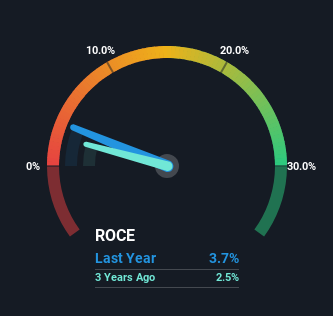- Singapore
- /
- Specialty Stores
- /
- SGX:5SO
Duty Free International (SGX:5SO) Has Some Difficulty Using Its Capital Effectively
If you're looking at a mature business that's past the growth phase, what are some of the underlying trends that pop up? Typically, we'll see the trend of both return on capital employed (ROCE) declining and this usually coincides with a decreasing amount of capital employed. This indicates the company is producing less profit from its investments and its total assets are decreasing. So after glancing at the trends within Duty Free International (SGX:5SO), we weren't too hopeful.
What Is Return On Capital Employed (ROCE)?
If you haven't worked with ROCE before, it measures the 'return' (pre-tax profit) a company generates from capital employed in its business. To calculate this metric for Duty Free International, this is the formula:
Return on Capital Employed = Earnings Before Interest and Tax (EBIT) ÷ (Total Assets - Current Liabilities)
0.037 = RM17m ÷ (RM487m - RM32m) (Based on the trailing twelve months to May 2023).
So, Duty Free International has an ROCE of 3.7%. In absolute terms, that's a low return and it also under-performs the Specialty Retail industry average of 8.4%.
View our latest analysis for Duty Free International

Historical performance is a great place to start when researching a stock so above you can see the gauge for Duty Free International's ROCE against it's prior returns. If you want to delve into the historical earnings, revenue and cash flow of Duty Free International, check out these free graphs here.
The Trend Of ROCE
The trend of returns that Duty Free International is generating are raising some concerns. The company used to generate 9.8% on its capital five years ago but it has since fallen noticeably. In addition to that, Duty Free International is now employing 26% less capital than it was five years ago. The fact that both are shrinking is an indication that the business is going through some tough times. If these underlying trends continue, we wouldn't be too optimistic going forward.
What We Can Learn From Duty Free International's ROCE
To see Duty Free International reducing the capital employed in the business in tandem with diminishing returns, is concerning. In spite of that, the stock has delivered a 12% return to shareholders who held over the last five years. Regardless, we don't like the trends as they are and if they persist, we think you might find better investments elsewhere.
Since virtually every company faces some risks, it's worth knowing what they are, and we've spotted 2 warning signs for Duty Free International (of which 1 is significant!) that you should know about.
While Duty Free International isn't earning the highest return, check out this free list of companies that are earning high returns on equity with solid balance sheets.
New: Manage All Your Stock Portfolios in One Place
We've created the ultimate portfolio companion for stock investors, and it's free.
• Connect an unlimited number of Portfolios and see your total in one currency
• Be alerted to new Warning Signs or Risks via email or mobile
• Track the Fair Value of your stocks
Have feedback on this article? Concerned about the content? Get in touch with us directly. Alternatively, email editorial-team (at) simplywallst.com.
This article by Simply Wall St is general in nature. We provide commentary based on historical data and analyst forecasts only using an unbiased methodology and our articles are not intended to be financial advice. It does not constitute a recommendation to buy or sell any stock, and does not take account of your objectives, or your financial situation. We aim to bring you long-term focused analysis driven by fundamental data. Note that our analysis may not factor in the latest price-sensitive company announcements or qualitative material. Simply Wall St has no position in any stocks mentioned.
About SGX:5SO
Duty Free International
An investment holding company, operates as a duty-free retailer under the Zon brand in Malaysia.
Flawless balance sheet with proven track record.
Market Insights
Community Narratives




